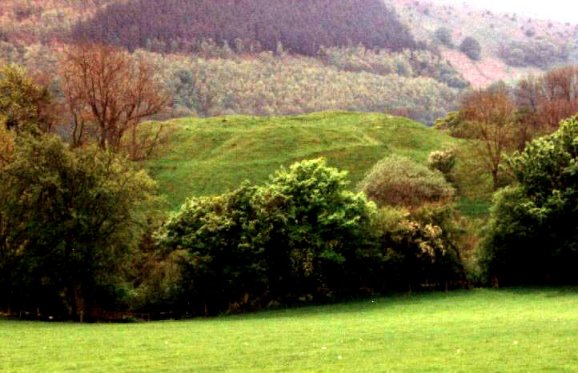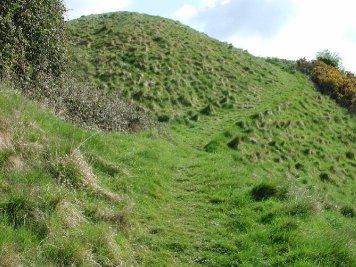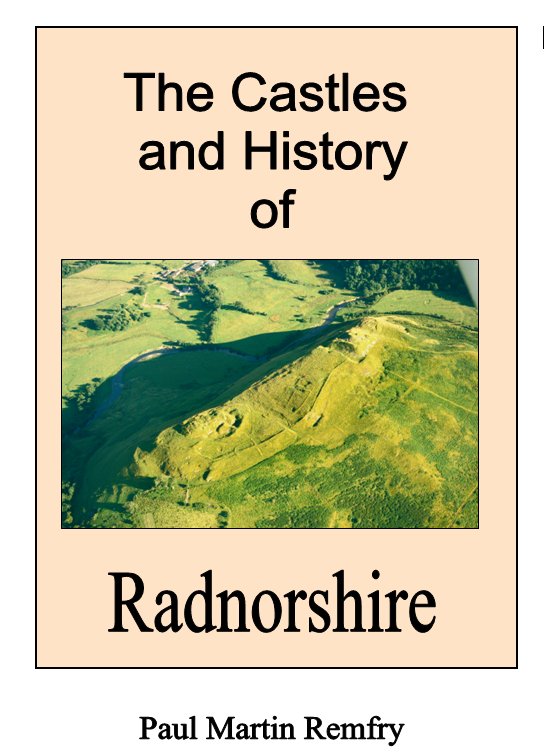New Radnor
There has been
much argument over the age of New
Radnor castle. Traditionally it is the successor of Old Radnor castle
or Castell
Nimble. Tradition in this case is undoubtedly wrong. New Radnor castle
was
possibly founded as early as the days of William
Fitz
Osbern in the Herefordshire Marches (1067-71) and it is
certain that the
Radnor plain to the east of New Radnor castle was considered English
land in
1086. This would suggest a castle constructed by this date. Certainly
by 1093
the fortress was operational and probably a base for the owning family
of Braose
in their conquest of the nearby cantref of Buellt.
 For
the first hundred years of its existence Radnor castle seems to have
been
relatively peaceful. The castle's lord, Philip Braose (1060-1138), was
certainly
here before setting off on Crusade around 1120 and his charter suggests
that a
vibrant borough was already flourishing beneath the castle walls. In
the 1160s
however all this changed and the castle was brought under increasing
Welsh
pressure which reached its zenith in 1182 when the local princes of
Elfael
seized Radnor castle after the disastrous defeat of William Braose at
the battle
of Dingestow. In 1188 Prince Einion o'r Porth (d.1191) of Elfael and
Prince Rhys ap
Gruffydd (d.1197) of Deheubarth met Giraldus Cambrensis and Archbishop Baldwin
of
Canterbury here when they travelled around Wales preaching the Crusade.
In 1195
the Braose family, probably in the form of Matilda St
Valery, returned and rebuilt the castle during the general
Marcher offensive
of that year. The next year Prince
Rhys
counterattacked and destroyed Radnor, both town and castle.
The result was
Rhys' decisive victory at the battle
of Radnor.
Rhys died the next year, 1197, of the plague and by 1200 William Braose
was back
at Radnor and receiving encouragement from King
John to capture what he could of Welsh territory from his
base at Radnor.
However, after the Braose rebellion
of 1208 John
seized the castle for the Crown, only to lose it Bishop Giles Braose in
1215. In
1216 John struck back and Radnor castle was again destroyed.
For
the first hundred years of its existence Radnor castle seems to have
been
relatively peaceful. The castle's lord, Philip Braose (1060-1138), was
certainly
here before setting off on Crusade around 1120 and his charter suggests
that a
vibrant borough was already flourishing beneath the castle walls. In
the 1160s
however all this changed and the castle was brought under increasing
Welsh
pressure which reached its zenith in 1182 when the local princes of
Elfael
seized Radnor castle after the disastrous defeat of William Braose at
the battle
of Dingestow. In 1188 Prince Einion o'r Porth (d.1191) of Elfael and
Prince Rhys ap
Gruffydd (d.1197) of Deheubarth met Giraldus Cambrensis and Archbishop Baldwin
of
Canterbury here when they travelled around Wales preaching the Crusade.
In 1195
the Braose family, probably in the form of Matilda St
Valery, returned and rebuilt the castle during the general
Marcher offensive
of that year. The next year Prince
Rhys
counterattacked and destroyed Radnor, both town and castle.
The result was
Rhys' decisive victory at the battle
of Radnor.
Rhys died the next year, 1197, of the plague and by 1200 William Braose
was back
at Radnor and receiving encouragement from King
John to capture what he could of Welsh territory from his
base at Radnor.
However, after the Braose rebellion
of 1208 John
seized the castle for the Crown, only to lose it Bishop Giles Braose in
1215. In
1216 John struck back and Radnor castle was again destroyed.
After the
death of King John, Reginald Braose
rebuilt Radnor castle. It was destroyed again by Prince Llywelyn ab
Iorwerth in
1231. Two years later Earl Richard of Cornwall rebuilt the fortress at
his own
cost and in the 1240's it passed to Ralph
Mortimer of
Wigmore to guard for his son and heir, Roger Mortimer, who
had married the
Braose heiress, Matilda. In 1264 Prince Llywelyn ap Gruffydd allied
with the
sons of Earl Simon Montfort of
Leicester and sacked
Radnor castle. Once more the castle was rebuilt, though this proved to
be its
final destruction in battle. In all the castle had changed hands twelve
times in
only eighty years! On four of these occasions the castle was
'destroyed'. New
Radnor is obviously the most unlucky castle in Wales! In maturity the
castle
proved much more sedate. It was defended against Owain Glyndwr, but the
story of
the castle's fall and the massacre of the garrison in 1403 is much
later legend
that has no basis in fact. Radnor castle then gently fell into decay,
by 1538
only one tower remained usable and that was used as the county prison.
 Description
Description
The
castle today consists of a great ringwork set on a natural buff
overlooking the
town of New Radnor. Despite claims to the contrary there is no
sign of an artifical motte built to carry a keep. There is merely
the hillside scarped into the ringwork. This ringwork was once
heavily defended in stone
and there
appears to be traces of four corner towers and a twin towered gatehouse
to the
north. The gatehouse was further protected by a double ditch, the
outermost cut
of which is obviously unfinished and probably dates to the rebuilding
of 1233.
Beyond this is a large outer ward with foundations of a building which
may have
been a great hall or stables. Nestling beneath the castle is the
town
church
which was totally rebuilt in the Victorian era. However, hidden
under
the stairs
are the effigies of a knight and his lady. The knight holds a
round
shield and a
spear. This is a typically Welsh armourment and the question must
be
asked, is
this the effigy of Prince Einion o'r Porth who held the town from 1182
to 1195?
Or maybe his father, Einion Clud, who was murdered at Christmas
1177 after joinly founding Abbey Cwmhir with his brother, Cadwallon ap Madog? Probably
we shall
never know.
Order Radnor Castle at £9.95
through the PayPal basket below.

The Castles and History of
Radnorshire (ISBN 1-899376-82-8)
looks in great detail at New Radnor castle and the surrounding
fortresses.
The book consists of 309 pages of A4 and
examines in greater detail the history and castles of Radnorshire and Rhwng Gwy a Hafren.
Starting in the early eleventh century the book covers the
age of the castles up to the Civil War of 1642-46.
Each castle description is buttressed by numerous photographs
and plans of the earthworks and remains where they survive. A
new look is also taken at the battlefield of Pilleth and the evidence
for the course of the battle is scrutinised. The book also
contains genealogical family trees of the major historical Radnorshire
families and a full index.
Available for £39.95.
Copyright©2004
Paul Martin Remfry
 For
the first hundred years of its existence Radnor castle seems to have
been
relatively peaceful. The castle's lord, Philip Braose (1060-1138), was
certainly
here before setting off on Crusade around 1120 and his charter suggests
that a
vibrant borough was already flourishing beneath the castle walls. In
the 1160s
however all this changed and the castle was brought under increasing
Welsh
pressure which reached its zenith in 1182 when the local princes of
Elfael
seized Radnor castle after the disastrous defeat of William Braose at
the battle
of Dingestow. In 1188 Prince Einion o'r Porth (d.1191) of Elfael and
Prince Rhys ap
Gruffydd (d.1197) of Deheubarth met Giraldus Cambrensis and Archbishop Baldwin
of
Canterbury here when they travelled around Wales preaching the Crusade.
In 1195
the Braose family, probably in the form of Matilda St
Valery, returned and rebuilt the castle during the general
Marcher offensive
of that year. The next year Prince
Rhys
counterattacked and destroyed Radnor, both town and castle.
The result was
Rhys' decisive victory at the battle
of Radnor.
Rhys died the next year, 1197, of the plague and by 1200 William Braose
was back
at Radnor and receiving encouragement from King
John to capture what he could of Welsh territory from his
base at Radnor.
However, after the Braose rebellion
of 1208 John
seized the castle for the Crown, only to lose it Bishop Giles Braose in
1215. In
1216 John struck back and Radnor castle was again destroyed.
For
the first hundred years of its existence Radnor castle seems to have
been
relatively peaceful. The castle's lord, Philip Braose (1060-1138), was
certainly
here before setting off on Crusade around 1120 and his charter suggests
that a
vibrant borough was already flourishing beneath the castle walls. In
the 1160s
however all this changed and the castle was brought under increasing
Welsh
pressure which reached its zenith in 1182 when the local princes of
Elfael
seized Radnor castle after the disastrous defeat of William Braose at
the battle
of Dingestow. In 1188 Prince Einion o'r Porth (d.1191) of Elfael and
Prince Rhys ap
Gruffydd (d.1197) of Deheubarth met Giraldus Cambrensis and Archbishop Baldwin
of
Canterbury here when they travelled around Wales preaching the Crusade.
In 1195
the Braose family, probably in the form of Matilda St
Valery, returned and rebuilt the castle during the general
Marcher offensive
of that year. The next year Prince
Rhys
counterattacked and destroyed Radnor, both town and castle.
The result was
Rhys' decisive victory at the battle
of Radnor.
Rhys died the next year, 1197, of the plague and by 1200 William Braose
was back
at Radnor and receiving encouragement from King
John to capture what he could of Welsh territory from his
base at Radnor.
However, after the Braose rebellion
of 1208 John
seized the castle for the Crown, only to lose it Bishop Giles Braose in
1215. In
1216 John struck back and Radnor castle was again destroyed.
